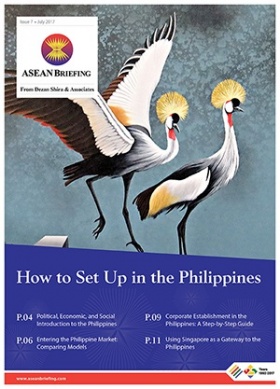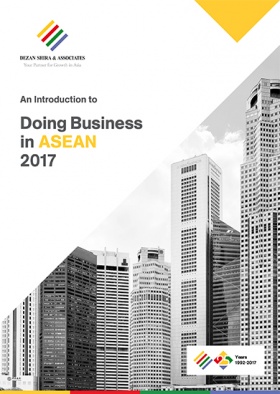The Philippines’ Investment Outlook for 2018
By: Vasundhara Rastogi
The Philippines is now among the fastest growing economies in Asia. Driven by a broad-based expansion in domestic demand, its economy has continued to perform strongly in 2017. The country’s gross domestic product (GDP) grew by 6.7 percent in the first three quarters of 2017, in comparison to the projected 6.6 percent. The Philippines has grown at an average of 6.3 percent over the past five years in what economists expect will be a sustained trend in the next few years for the country.
The sustainability of economic growth and the economy’s limited exposure to uncertainty in global markets makes the Philippines an attractive investment destination in Asia for overseas investors. Duterte’ ascension to the presidency in 2016 has further strengthened the economy’s growth prospects. Known as a pro-reform, pro-infrastructure and anti-corruption president, Duterte has already introduced several big infrastructure projects that have the ability to make the country grow stronger in the coming years.
![]() RELATED: Pre-Investment and Market Entry Advisory from Dezan Shira & Associates
RELATED: Pre-Investment and Market Entry Advisory from Dezan Shira & Associates
Investment climate
In 2017, the World Bank’s Doing Business Report ranked Philippines 99th compared to 103rd in the previous year. Over the last six years, the country’s investment climate has shown remarkable progress, improving the country’s ranking by 49 spots in the Doing Business Report. In order to enhance its doing business ranking and encourage foreign investment, the Philippines has taken several initiatives to protect minority investors, and ease the procedures dealing with construction permits, paying taxes and enforcing contracts.
Recently in 2017, the Philippines government released a list of industries and service areas that will receive government support through fiscal and non-fiscal incentives. The 2017 investment priority plan, themed ‘Scaling Up and Disbursing Opportunities’ sustains many of the old investment incentives offered by the government but has now broadened its coverage. New “preferred” areas that are eligible to receive incentives from the Board of Investment (BOI) under the list include the following:
- manufacturing including agri-processing;
- agriculture, fishery and forestry;
- strategic services;
- infrastructure and logistics including local government unit public-private partnerships;
- health care services including drug rehabilitation;
- mass housing;
- inclusive business models;
- environment and climate change;
- innovation drivers; and
- energy
Also deemed priorities are:
• export businesses including services, activities in support of exporters, and production and manufacture of export products;
• activities based on special laws that grant incentives like Republic Act (RA) No. 7942 or the Philippine Mining Act of 1995, RA 9513 or the Renewable Energy Act of 2008 and RA 9593 or the Tourism Act of 2009, among others;
• and the Autonomous Region in Muslim Mindanao
Tax reform
One of the key highlights of the Philippines economy in 2017 was the implementation of the Tax Reform for Acceleration and Inclusion Act (TRAIN) which exempts those earning an annual taxable income of R250,000 (US$5000) and below from personal income tax. The 13th-month pay and other bonuses amounting to R90,000 (US$1800) are also tax-exempt. By increasing the net income of workers, the Philippines’ economy will greatly benefit either from increased consumption or greater savings or investments. Another underlying objective of TRAIN is to create job opportunities and bring in foreign investment. This will raise government’s overall fiscal capacity to finance public investment, especially for critical infrastructure projects such as transportation, and help sustain economic growth. According to the Philippine development plan the current tax to GDP ratio is around 14 percent. The tax reform will push the ratio upward towards 15 percent.
Key Industries
The Philippines is becoming more competitive as a regional manufacturing player supported by strong domestic consumption and export markets. Exports have been one of the primary revenue drivers for the Philippines, with the electronics manufacturing services and semiconductor manufacturing accounting for around 51 percent of the export revenues. Prioritized under the Manufacturing Resurgence Program (MRP), the manufacturing sector accounts for 23 to 25 percent of GDP. Over a period of time, the country is expected to strengthen its manufactured exports with rising FDI inflows. With a population of over 104 million and a high literacy rate, the Philippines has become the most preferred choice of electronics manufacturing – and related investments.
Other key industries in Philippines are information technology (IT), business processing management (BPM) sectors, construction, healthcare, retail, food & beverage, and energy.
 RELATED: The Philippines’ New Tax Reform Package Approved
RELATED: The Philippines’ New Tax Reform Package Approved
Outlook 2018
The Philippine economy has picked up pace in the recent times, expanding by 6.7 percent in the first three quarters of 2017. The growth was largely led by increased foreign investment and robust consumption. In 2018, both the International Monetary Fund (IMF) and World Bank expect the Philippines’ GDP to grow slightly faster – between 6.7 and 6.8 percent compared with its earlier projections of 6.6 percent. Amid a recovery in external trade, strong consumer spending and investment, the Philippines is expected to remain one of South East Asia’s top economies in 2018.
As seen in 2017, the government significantly increased its public expenditure to achieve its target of spending 5.3 percent of GDP on public infrastructure, and the household consumption too remained strong, despite moderating slightly from previous year. The government’s commitment to further increasing public investment by the implementation of big infrastructure projects is expected to sustain the country’s growth momentum through 2018 and reinforce business and consumer confidence in the economy. Strong domestic demand supported by expansionary fiscal policy as well as higher local employment is expected to push Philippines economic growth on a higher growth trajectory.
About Us
ASEAN Briefing is produced by Dezan Shira & Associates. The firm assists foreign investors throughout Asia and maintains offices throughout ASEAN, including in Singapore, Hanoi, Ho Chi Minh City and Jakarta. Please contact us at asia@dezshira.com or visit our website at www.dezshira.com.
- Previous Article How to Set Up in Thailand – New Issue of ASEAN Briefing Magazine
- Next Article Rules of Origin Criteria of ASEAN’s Free Trade Agreements





